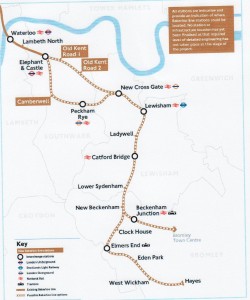You may have seen reports on TV news and BBC’s Sunday Politics, and in the Evening Standard for proposals to extend the Bakerloo Line to Hayes and Beckenham Junction. You can see the proposals and comment at
https://consultations.tfl.gov.uk/tube/bakerloo-extension
The closing date is 7 DECEMBER 2014. We will also be discussing this at the Residents’ Forum at Beckenham Public Halls, 8pm 15 October.
In summary the main points seem to be
- An extension of the Bakerloo line from Elephant and Castle to Lewisham, with two options for routes – going either through the Old Kent Road or Camberwell and Peckham – this would be new construction.
- Then potential extensions from Lewisham to Hayes and Beckenham Junction, possibly through to Bromley. Another option is for the extension to end at Lewisham, leaving the existing Southeastern rail line unchanged.
- The Hayes extension would be made by replacing the existing national rail line with an “underground” line (but above ground, obviously). The route from Hayes into central London would be Hayes to Lewisham then round Elephant and Castle to Waterloo and Charing Cross and onwards to central London and Paddington. To get to London Bridge, you would have to change to the railway at Lewisham.
- On the Hayes line, there would be 15 trains an hour, compared with 4 at present. That’s one every 4 mins. On the Beckenham Junction line, there would be 6 tube trains an hour in addition to the current 6 rail trains.
- TfL claim that journey times to Charing Cross and Cannon Street would be cut by about 10 minutes.
- The Beckenham Junction extension would not affect the lines into Victoria, but the line between New Beckenham and Beckenham Junction would be replaced by the Bakerloo line. If it was extended to Bromley, this part of the route would include a tunnel.
- The line would be funded in part by contributions from developers along the line – this is clearly part of the Mayor’s development strategy for our area. So the additional trains would cater for an expected much larger local population.
- Timescale – starting sometime 2020-2025, finished sometime 2030-2035.

